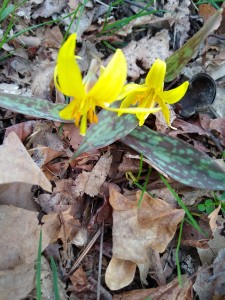
We are approaching the vernal equinox, when, as the name suggests, the hours of daylight and darkness are equal. It happens again in the fall with the autumnal equinox, but I think the spring event is happier and more hopeful, because the days continue to lengthen afterwards
If the word “equinox” is full of possibilities, so is the word “vernal”, which is descended from the Latin “vernalis”, and means “of spring”. In the spring, low spots in the woods are home to vernal pools that teem with life during the season, but dry up once warmer weather sets in. And then there are vernal flowers, often called “spring ephemerals”. These plants pop up early in the spring and last just long enough to restore hope after a long winter. Spring ephemerals are quick about their work, rising from the ground, flowering and setting seed in the space of a few weeks. Afterwards they oblige the late spring and summer plants by disappearing for the rest of the year.
Some spring ephemerals are indigenous or “wild” plants, like the native dogtooth violet or Erythronium americanum. Others originated elsewhere in the world, like the well-loved narcissus, tulips and hyacinths. They are a little less ephemeral than the natives, because the daffodil and tulip leaves hang around a bit longer, but they still disappear by the first days of summer.
I love to explore uncultivated areas near my home—the edges of parks, railroad rights-of-way and the edges of local streams–to look for the first spring ephemerals. One of the parks near my home is edged by a stream. A few years ago I was walking by the stream and noticed that the ground was carpeted with elongated 1.5 inch green leaves speckled with brown. One of the nicknames of dogtooth violet is “trout lily” and the leaves bore those trout speckles. Though not in bloom, I knew the leaves near my feet were dogtooth violets.
Another wild ephemeral that blooms in the same damp conditions is marsh marigold—Caltha palustris—a ground-hugging member of the buttercup family with rounded leaves and yellow daisy-shaped flowers. When marsh marigolds are happy, they form bright yellow carpets that are glorious while they last. If you see those carpets, take a picture, because chances are the flowers will have disappeared by the next time you visit the spot.
Some of the wild ephemerals seem downright magical. Trilliums lead that pack. As the Latin name suggests, the leaves, petals and sepals all appear in groups of threes. The plants frequent woodland edges and feature large flowers with waxy petals. The great white trillium or Trillium grandiflorum, is one of the showiest, with pure white petals that age to pink. My garden is home to a vigorous clump of yellow trillium or Trillium luteum, which features mottled leaves and yellow flower petals. I ignore it completely and it has responded by multiplying vigorously, emerging from a mess of English ivy and eventually disappearing back into it.
Lady’s slipper orchids (Cypripedium) are a welcome sight, partially because they are so beautiful and also because they are rarer now than they were in 50 years ago. Development, pollution and wild collection have done that, so if you are fortunate enough to see a lady’s slipper in the wild, treasure that opportunity.
We are all so familiar with exotic tropical orchids that it is even more amazing to see a native, terrestrial orchid at the edge of a wooded area. The lady’s slippers are distinctive because each flower wears a “slipper”, which is a pouch-like petal that faces downward and is accented by two, smaller twisting petals. The flowers can be white, pink or yellow, depending on the species.
If you see a lady’s slipper in the wild, take its picture, but do not pick the flower or attempt to dig the plant. Lady’s slippers need a highly specialized growth environment and do not transplant successfully.
There are so many other ephemerals—tiny pink-striped Claytonia or spring beauty, the pantaloon flowers of Dutchman’s breeches or Dicentra cucullaria, and the four-petaled yellow flowers and ferny foliage of the native celandine poppy—Stylophorum diphyllum—among others. Find the less tended areas near you and look for them. They are there, and the more people who know about them, the better their chances of survival in changing ecosystems.
“Ephemeral” should mean “departs in the summer”, not “departs forever”. We have a responsibility to keep the departure seasonal.
